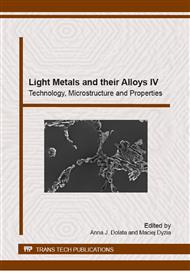[1]
J. Dobrovská, S. Dočekalová, B. Smetana, Study of cooling effect on transformation temperatures in the course of in 738 LC solidification, Acta Metallurgica Slovaca, 13 (4), (2007), 539 – 545.
Google Scholar
[2]
L. A. Chapman, Application of high temperature DSC technique to nickel based superalloys, Journal of Materials Science 39 (2004) 7229 – 7236.
DOI: 10.1023/b:jmsc.0000048736.86794.12
Google Scholar
[3]
R.I. Wu and J.H. Perepezko, Liquidus Temperature Determination in Multicomponent.
Google Scholar
[4]
Alloys by Thermal Analysis, Metallurgical and Materials Transactions, 31A, (2000) 497-501.
Google Scholar
[5]
R. Przeliorz, M. Góral, G. Moskal, L. Swadźba, The relationship between specific heat capacity oxidation resistance of TiAl alloys. Journal of Achievements in Materials and Manufacturing Engineering. 1 (2007) 47-50.
Google Scholar
[6]
K. D. Maglic, A. Cezairliy, V. E. Peletsky, Compendium of Thermophysical Property Measurement, Methods: 1 Survey of Measurement Techniques, (Plenum Press, New York, 1984).
Google Scholar
[7]
X.B. Liu, R.S. Chen, E.H. Han, Effects of ageing treatment on microstructures and properties of Mg-Gd-Y-Zr alloys with and without Zn addition, Journal of Alloys and Compounds 465 (2008) 232-238.
DOI: 10.1016/j.jallcom.2007.10.068
Google Scholar
[8]
A. Kiełbus, T. Rzychoń, R. Przeliorz, DSC and Microstructural Investigations of The Elektron 21 Magnesium. Materials Science Forum, 638-642 (2010) 1447-1452.
DOI: 10.4028/www.scientific.net/msf.638-642.1447
Google Scholar
[9]
G. Höhne, W. Hemminger and H.J. Flammersheim, Differential Scanning Calorimetry an Introduction for Practitioners, Springer (1996).
DOI: 10.1007/978-3-662-03302-9_1
Google Scholar
[10]
R.I. Wu and J.H. Perepezko, Liquidus Temperature Determination in Multicomponent.
Google Scholar
[11]
Alloys by Thermal Analysis, Metallurgical and Materials Transactions, 31A, (2000), 497-501.
Google Scholar
[12]
Estimation Method for Liquidus Temperature of Lead-Free Solder Using Differential Scanning Calorimetry Profiles, Journal of Electronic Materials, 38, (12), (2009) Special Issue Paper, 2610-2616.
DOI: 10.1007/s11664-009-0921-1
Google Scholar
[13]
E. Gmelin and St.M. Sarge, Calibration of differential scanning calorimeters. Chem., 67, (11), (1995) 1789-1800.
DOI: 10.1351/pac199567111789
Google Scholar
[14]
A.T.W. Kempen, F. Sommer, E.J. Mittemeijer, Calibration and desmering of a differential thermal analysis measurment signal upon heating and cooling, Thermochimica Acta 383 (2002) 21-30.
DOI: 10.1016/s0040-6031(01)00699-2
Google Scholar
[15]
Stefan M. Sarge, Günter W.H. Höhne, Heiko K. Cammenga, W. Eysel, E. Gemelin, Temperature, heat and heat fow rate calibration of scanning calorimeters in the cooling mode. Thermochimica Acta 361 (2000), 1-20.
DOI: 10.1016/s0040-6031(00)00543-8
Google Scholar
[16]
ISO norm 11357-1.
Google Scholar


